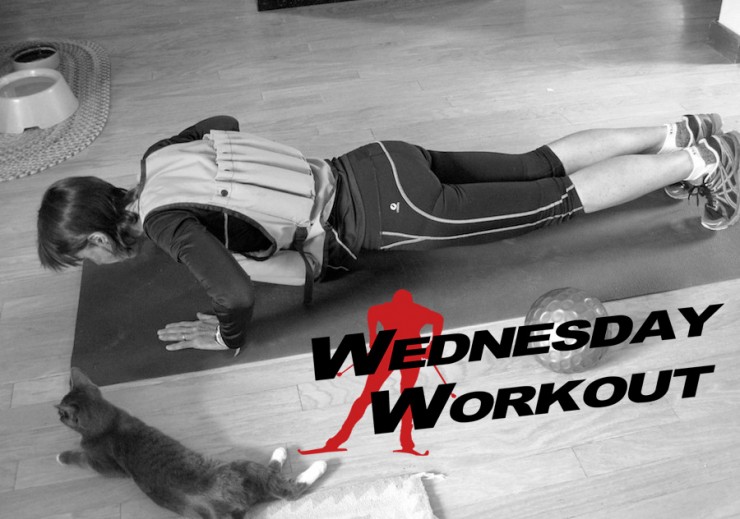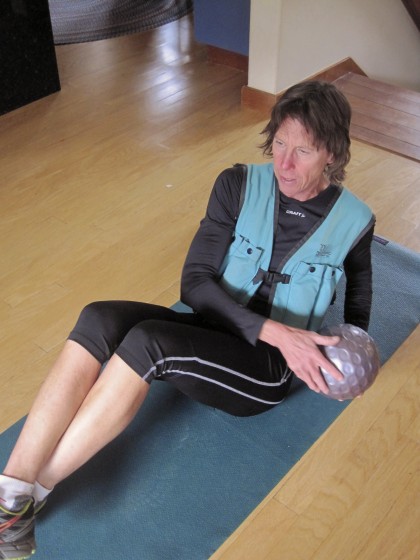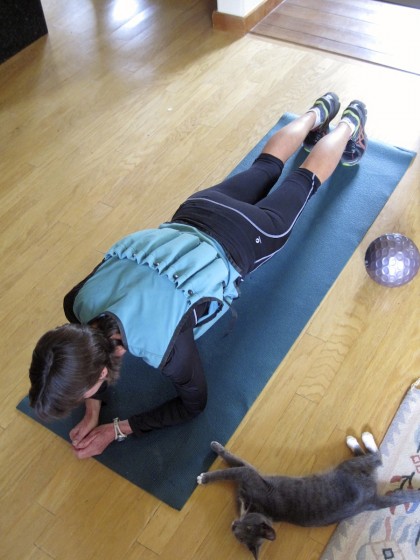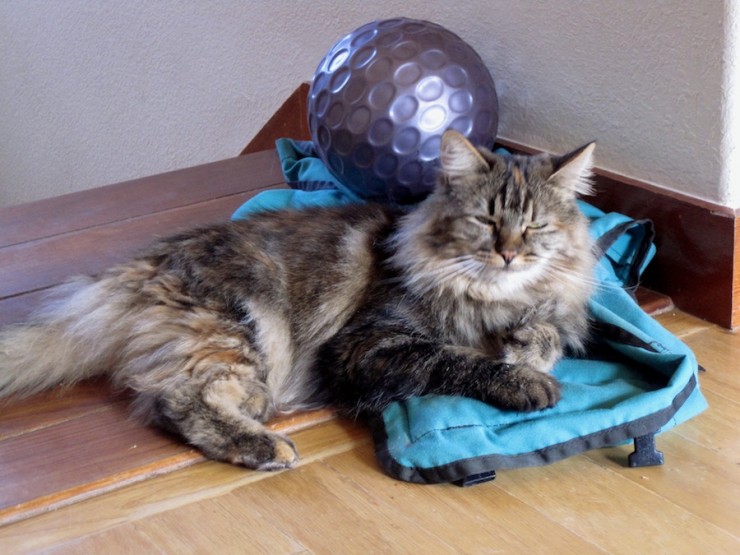
Walking through the garage the other day, I spied my turquoise weight vest languishing in the corner. I became very excited, not because I wanted to actually use it, but because it was a seemly topic for a Wednesday Workout.
This particular weight vest had, until recently, taken a very long vacation from any kind of work. My former coach Torbjørn Karlsen had generously supplied the vest back in the early ’90s, when I was in full ski training mode. It is made of a canvas-type material and has numerous long, thin pockets that hold sandbags and wrap completely around it. Fully loaded, my vest holds 10 evenly distributed pounds.

The weight vest had been a staple of my strength training and I had been pleased to pull the thing out a couple of summers ago when my daughter, Laurel, was ready to incorporate it into her dryland training. She was 17 and had been doing a general and specific strength program for several months. It was the perfect way to add resistance to the exercises we had been doing in our outdoor gym. We also added it to some of our specific strength sessions on rollerskis.
When used properly, a weight vest enhances a strength-training program, especially when it is not possible (or affordable) to train in a fully equipped gym. It is a simple tool that provides enough resistance to make some good strength gains! It may be necessary to begin with the vest lightly loaded for the first couple of times.
The Workout: Circuit Training
– Warm up as you normally would for strength training.
– Choose 5 or 6 exercises for your workout.
For example:
- Push-ups
- Pull-ups
- Triceps press
- Step-ups
- Planks
- Kayakers with a ball

Complete one set of the exercises without the weight vest, then do two more sets with the vest. Pay close attention to proper form when wearing the vest. Wearing the vest, it will be possible to do only half to two thirds of the repetitions as without the vest.
The Workout: Specific Strength
This workout can be accomplished on rollerskis or skis.
– Warm up for 20 minutes.
The following exercises can be done on a variety of terrain, but to start, seek moderately steep terrain that it is possible to double pole or single stick up without loss of technique. It is recommended that the skier have a good base of general and specific strength before attempting weight-vest training.
Double-Pole Repeats
- Wearing the weight vest, double pole for 1 minute up the hill.
- Repeat the same drill without the weight vest, concentrating on quickness of movement.
- Continue to do the 1 minute repeats, alternating wearing the vest and without. Focus on getting hips quickly up and forward.
- Begin with 2-3 cycles and work up to 5.
“Locked and Loaded”
- Wearing the vest, isolate the initiation phase of the double pole by tapping the poles into the snow or pavement from the high and forward position. This will feel like an upper abdominal muscle crunch. The poles will not follow through, as this is not a full double pole! Try repetitions of 30 seconds.
- Repeat the “locked and loaded” drill without the vest.
- Begin with 2-3 cycles and work up to 5.
Single-Stick Repeats
- Choose a more gradual hill than used for double poling.
- Wearing the weight vest, single stick (no legs) for 45 seconds up the hill.
- Repeat without the vest, concentrating on speed of arm swing forward.
- Continue the 45-second repeats, alternating with and without the vest. Focus on engaging the core and keeping hips up and forward, which will allow a free and swift arm swing.
- Begin with 2-3 cycles and work up to 5.
It is possible to mix the above exercises into a single workout, aiming for a total of 12-15 repeats, or to just work on one set of exercises. Finish the workout with an easy cool-down.
My 25-year-old weight vest has been surpassed by newer, sleeker models. There are a number of good weight vests on the market. Choose one that fits snugly to the torso and has even, weight distribution. A final word of advice: don’t begin your weight vest training with a fully loaded vest!

Nancy Fiddler
Nancy Fiddler is a two-time Olympian and 14-time National Champion. She has been coaching juniors and masters for 20 years in Mammoth Lakes and Truckee, Calif., and most recently in Sun Valley, Idaho. She lives most of the time in the Eastern Sierra with her husband and daughter and is currently trying to get in touch with her creative side through writing.



